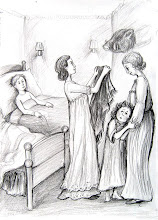Rowley, Alison. “Before Her Time? Lily Briscoe and painting now”. Unframed: Practices and Politics of Women's Contemporary Painting. Ed. Rosemary Betterton. I. B. Tauris, 2004. 17-39
Alison Rowley’s assessment of Lily Briscoe touches on both the influence of Roger Fry, and the introduction of psychoanalysis in Woolf’s life. Reflecting Roger Fry’s theories on art, Lily Briscoe’s Post-Impressionistic artistic vision differs from the “pale, elegant, semi-transparent” (TtL 22) style of the currently popular Impressionists, embodied by the fictional Mr. Paunceforte. Rowley tells us that “Woolf’s abiding fear about her experiments with narrative structure in her search to write the reality of character as a succession of ‘moments of being’ was that the novels would read as ‘pale’ and ‘semi-transparent’.” (22) Furthermore, Rowley sees a connection between Lily’s feelings about Mrs. Ramsay and her struggle to find the correct compositional balance for her painting. She notes this connection in the thoughts that Lily has when she is beginning to paint, and her thoughts when she is sitting at Mrs. Ramsay’s knee. At the moment Lily first touches paint to fresh canvas, Woolf has filled Lily’s head with an image of birth: “It was in that moment’s flight between the picture and her canvas that the demons set on her who often brought her to the verge of tears and made this passage from conception to work as dreadful as any down a dark passage for a child.” (TtL 22-23) When Lily is sitting at Mrs. Ramsay’s knee, she thinks that Mrs. Ramsay is “like the treasures in the tombs of kings, tablets bearing inscriptions, which if one could spell them out, would teach one everything.” (TtL 54) Rowley points out that both the womb and the tomb bring forth their contents only after a period or an act of upheaval occurs. The upheaval of birth is evident, and Rowley reminds us that a tomb is always sealed; in order to know the treasures contained within, a tomb must be forcibly broken open. With respect to Woolf’s mother, Rowley quotes a passage from Woolf’s essay, ‘A Sketch of the Past’: “It is perfectly true that she obsessed me, in spite of the fact that she died when I was thirteen, until I was forty-four. Then one day walking around Tavistock Square I made up, as I sometimes make up my books, To The Lighthouse; in a great, apparently involuntary, rush…Why then? I have no notion. But I wrote the book very quickly; and when it was written, I ceased to be obsessed by my mother.” (25) Rowley observes, “In general, Woolf’s narrative appears to parallel Freud’s observation that it is the absence of the maternal body that motivates the activity of symbolic substitution” (31) and she goes on to propose that the primary object of symbolic substitution is the blank canvas that so intimidates Lily when she begins to paint.
Throughout To The Lighthouse, Woolf has included clear indications of her own struggle to resolve her feelings about her mother and to apply Roger Fry’s art theory to her own writing. While other works address these topics separately, Rowley’s work weaves these elements together seamlessly. Rowley’s concept adds to the perspective gained from earlier works, providing a confirmation of sorts. Highlighting Lily’s difficulties with the spatial arrangement of the objects in her painting, Rowley notes, “This basic aesthetic operation is linked to psychic yields of unpleasure and pleasure related to experiences of the unavailability/absence of the mother.” (30) Based on the passages that Rowley includes from Woolf’s essay ‘A Sketch of The Past’, it appears that the process of writing To The Lighthouse was healing for Woolf. The creation of Lily Briscoe, a female artist who manifested challenges faced by Woolf in her own life, seems to have been cathartic for Woolf, giving her the ability to find some sort of resolution for her feelings towards her mother. At the end of the book, Lily Briscoe looks at her (almost) complete painting and is certain that the painting is destined to be hung in attics and eventually be destroyed. Undeterred, she lifts her brush and creates the famous line in the center of the canvas. With that, she is finished, and she thinks to herself, “I have had my vision.” (TtL 211) It is as if Woolf herself is defining To The Lighthouse as her seminal work; if the manuscript had lain in an attic, unseen and turning to dust, Woolf would still have attained her healing catharsis. This perspective shows us that Lily’s creative expression through paint, and by extension Woolf’s creative expression through words, exists largely for her own internal well-being, independent of the opinions of others.
Tuesday, December 8, 2009
The Catharsis of Artistic Vision
Subscribe to:
Post Comments (Atom)



No comments:
Post a Comment